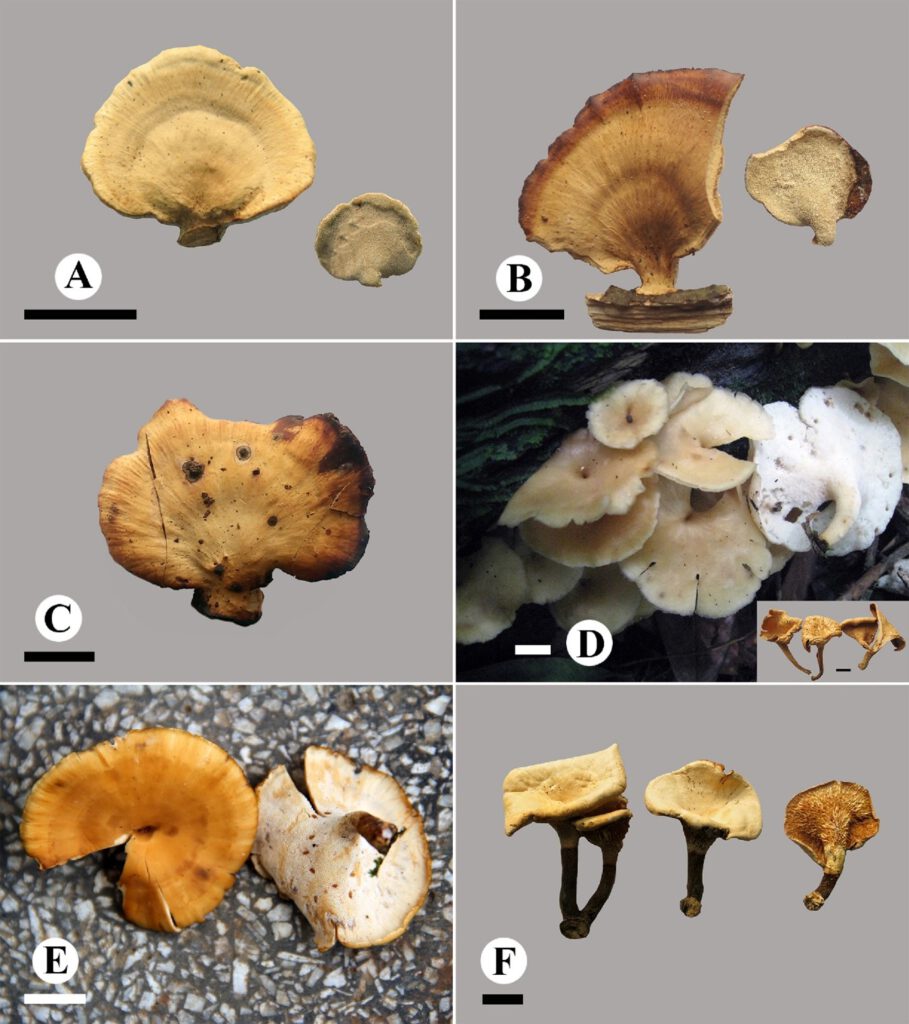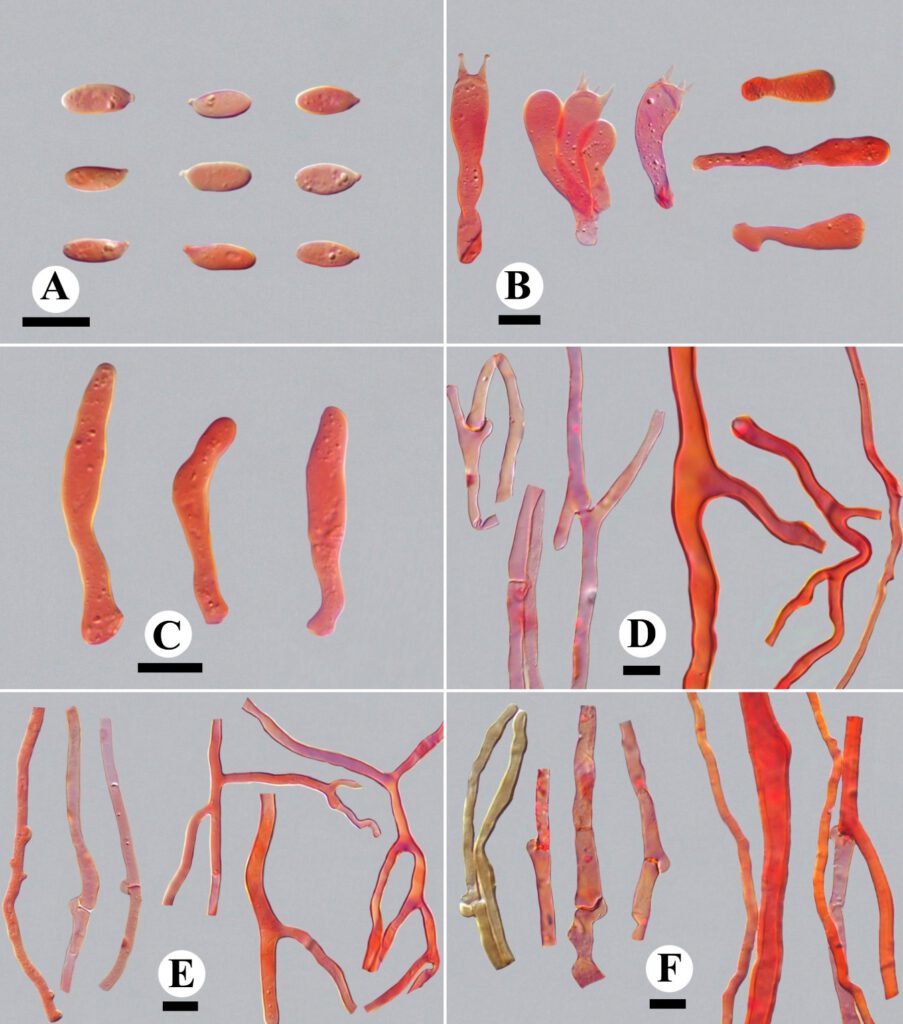Polyporus austrosinensis B.K. Cui, Xing Ji & J.L. Zhou, sp. nov.
MycoBank number: MB 559403; Index Fungorum number: IF 559403; Facesoffungi number: FoF 10651;
Description
Basidiomata – Annual, centrally stipitate, solitary, fleshy to soft leathery when fresh, becoming fragile when dry. Pilei horn-shaped or flat with a depressed centre, up to 6.3 cm in diam and 2 mm thick. Pileal surface cream, beige, buff yellow to orange when fresh, becoming buff to honey yellow when dry, glabrous, usually azonate; margin sharp, straight when fresh, incurved upon drying. Pore surface white when fresh, becoming yellow when bruised, turning to light ivory to buff when dry; pores angular, 4–7 per mm; dissepiments thin, entire. Context white, fleshy to soft leathery when fresh, becoming cream to ivory, fragile when dry, up to 2 mm thick. Tubes concolorous with pore surface or slightly lighter, decurrent, very thin, fragile when dry, less than 0.5 mm. Stipe white to ivory at the upper part and brown at the lower part when fresh, becoming ivory to buff at the upper part and beige brown to brown at the lower part when dry, glabrous, 1.5–3 cm long and 2.5–10 mm in diam.
Hyphal structure – Hyphal system dimitic; generative hyphae bearing clamp connections; skeleto-binding hyphae IKI–, CB+; tissues unchanged in KOH.
Context – Generative hyphae frequent, colorless, thin-walled, frequently branched, 2–8.8 μm in diam, occasionally inflated up to 14.8 μm in diam; skeleto-binding hyphae dominant, colorless, thick-walled with a wide lumen, moderately branched, interwoven, 1.5–10 μm in diam, occasionally inflated up to 19 μm in diam.
Tubes – Generative hyphae frequent, colorless, thin-walled, frequently branched, 2–5.5 μm in diam, occasionally inflated up to 8.7 μm in diam; skeleto-binding hyphae dominant, colorless, thick-walled with a wide lumen, moderately branched, interwoven, 1.5–7 μm in diam. Cystidia absent; cystidioles infrequent, bacciliform, 33–45 × 5.4–6.5 μm. Basidia clavate, with a basal clamp connection and four sterigmata, 22–45 × 7.5–9.8 μm; basidioles in shape similar to basidia, but slightly smaller.
Stipe – Generative hyphae frequent, colorless, thin-walled, occasionally branched, 3–8.5 μm in diam; skeleto-binding hyphae dominant, colorless, thick-walled with a wide to narrow lumen, infrequently branched, interwoven, 1.5–9 μm in diam, occasionally inflated up to 12.2 μm in diam. Hyphae in cuticle with brown beige to light brown inclusion inside, thick-walled with a wide lumen, bearing clamp connections, 2.3–5.6 μm in diam.
Basidiospores – Basidiospores cylindrical, colorless, thin-walled, smooth, occasionally bearing one small guttule, IKI–, CB–, (6.7–)7.5–10.6(–11.2) × (2.9–)3.3–4.4(−4.9) μm, L = 9.05 ± 0.87 μm, W = 3.82 ± 0.42 μm, Q = 2–2.86, Qm = 2.4 ± 0.21 (n=69/2).
Material examined: CHINA, on fallen angiosperm branch, 15 July 2013, B.K. Cui, Cui 11126 (BJFC, holotype), Cui 11123 (BJFC, paratype), Cui 11140 (BJFC, paratype); on angiosperm stump, 19 November 2015, B.K. Cui, Cui 13675 (BJFC, paratype).
Distribution: Tropical and subtropical regions of China.
Sequence data: Cui 11126: ITS: KX900045.1 (ITS4/ITS5); LSU: KX900161.1 (LROR/LR7); nSSU: KX900272.1 (PNS1/NS41); mtSSU: KX900229.1 (MS1/MS2); EF1a: KX900351.1 (983/1567R); RPB1: KX900385.1 (RPB1-Af/RPB1-Cr); RPB2: KX900308.1 (fRPB2-5F/bRPB2-7.1R); TUB: KX899936.1 (Bt-1a/Bt-1b) Cui 11140: ITS: KX900046.1 (ITS4/ITS5); LSU: KX900162.1 (LROR/LR7); nSSU: KX900273.1 (PNS1/NS41); mtSSU: KX900230.1 (MS1/MS2); EF1a: KX900352.1 (983/1567R); RPB1: KX900386.1 (RPB1-Af/RPB1-Cr); RPB2: KX900309.1 (fRPB2-5F/bRPB2-7.1R)
Fig. 2–E Basidiomata of Polyporus austrosinensis (Cui 11123). Scale bars: 1 cm. Fig. 11 Microscopic structures of Polyporus austrosinensis. (A): Basidiospores; (B): Basidia and basidioles; (C): Cystidioles; (D): Hyphae from context; (E): Hyphae from trama; (F): Hyphae from stipe. Scale bars: A-F = 10 μm.

Fig. 2

Fig. 11
